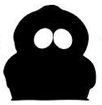When creating an episode of South Park, the first stage is always creating storyboards with character designs. Every joke and idea is thought about carefully, and the position of the characters in the shot also. A script is then written which will also contain camera angles and shots. Character designs will be finished, and sent to be lip synced to the characters. Then the animation process takes place; characters arms, legs, heads and eye and such are animated according to the script. The animators make an animatic first to get a sense of what the episode will look like
Dot (Created by Aardman Animations)
This short film was shot completely on a Nokia N8 smartphone in order to promote the product. It was shot under a microscope, as it is the smallest animation that has every been created. The character Dot was a 9mm tall resin model. The animators had to use 50 of these small models in order to compensate for damage, which was likely happen due to the size of the models. Each of these resin models was printed using a high tech 3D printer and thousands of layers of resin. A 2D drawing was made first so that accurate models could be printer on the 3D printer.
The type of animation use was stop-motion animation, a favourite choice in Aardmans case. The team had to take a compilation of pictures on the smartphone to make the stop-animation; A Dot model was placed in the painted setting, then a picture was taken, and then a different Dot model was put in place. This created a walking effect. The smartphone stayed in its mount for the entirety of the film, but the setting moved in order to create the illusion of movement.
Peppa Pig (Created, Directed and Produced by Astley Baker Davis)
The animators first come together and talk about ideas for episodes, and then start making storyboards, this makes it easier to create camera shots. The team then discuss colours, and set design to see what fits best on screen. The animation the takes place, using the computer programme Celacton 2D. The animators get the animals moving in the way that the director wants. Preciously recorder voice recordings are used so that the animators know how to move the characters mouths. When an episode is finished, the animators talk with the director, and discuss improvements that may need to be made.
























